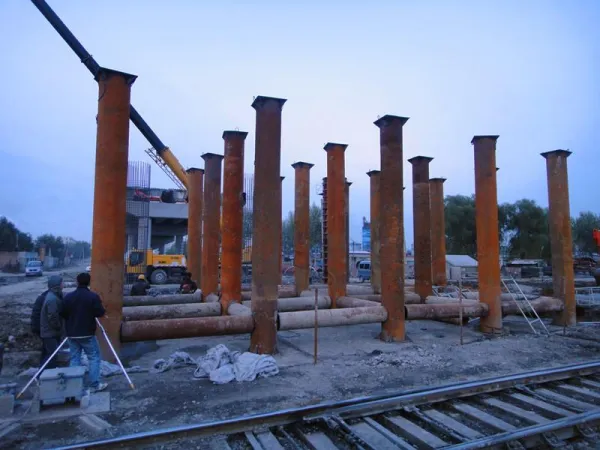The Indispensable Role of Pipe Piling in Construction
Pipe piling is a crucial element in modern construction, particularly in foundation projects that demand high load-bearing capacity and must adapt to complex geological conditions. These cylindrical structures are driven deep into the ground and primarily serve to support and stabilize buildings such as bridges, docks, seawalls, and other large, permanent structures. With their robust and durable properties, piling pipes can penetrate various soil layers until reaching a stable load-bearing stratum, thereby providing a secure foundation for the superstructure. Welded pipes, including
ERW types, are commonly used as piling pipes due to their structural integrity and construction efficiency.
Identifying problems: the key to extending the service life of piling pipes
Although piling pipes are designed for long-term use, the variability of the environment, loads and installation conditions may cause damage. Therefore, identifying early problems is crucial to prevent structural instability and avoid high repair costs.
Common signs of damage
Corrosion
Oxidative corrosion may occur in piling pipes after long-term exposure to air, water or soil. Rust or color changes are common signs of corrosion.
Cracks or breaks
Overloading, geological movement or improper installation operations may cause cracks or breaks. Even small cracks can quickly expand into serious problems if not repaired in time.
Bending or bending
Bending usually indicates that the pile pipe has exceeded its design load-bearing capacity and may be caused by material degradation or abnormal loading.
Position displacement
A noticeable change in the position of the pile pipe may be caused by soil movement, improper support or natural disasters such as earthquakes.
Erosion around the base
If the soil at the bottom of the pile is lost or eroded, the support and stability will be significantly reduced.
Material degradation
In addition to corrosion, steel can also experience other forms of degradation due to chemical attacks such as acids, bases or salts.
Leakage or seepage
For piles used underwater or in wet environments, leaks may mean that the integrity of the pipe body has been compromised.
Abnormal noise
If the pile pipe is subjected to excessive pressure, it may squeak or make other abnormal sounds, which requires prompt attention.
Effective repair technology for steel pipe piles
Depending on the type and severity of damage, appropriate repair methods can be selected to restore the structural integrity and functionality of the pile pipe.
1. Coating protection
For the corrosion protection needs of new steel piles, liquid coating systems such as coal tar epoxy resin or glass flake reinforced coating can be used before installation. These coatings can effectively resist chemical corrosion in the marine environment and extend the service life of the pile pipe.
2. Steel casing repair
Installing a steel casing in the damaged area and injecting grout to fill the gap can enhance structural support while sealing cracks or leaks. However, it should be noted that the construction process is relatively complicated and is suitable for large-scale repairs.
3. Cathodic protection
Using sacrificial anodes or impressed current methods, more active metals or currents are introduced into the pile pipe system to prevent electrochemical corrosion. Although the technical requirements are high, the long-term protection effect is significant.
4. Welding repair
Professional welders use high-temperature arcs to melt filler materials and repair cracks or fractured areas. This method is suitable for the restoration of structural damage, but requires professional equipment and technical support.
5. Epoxy resin injection
For small cracks, pressure injection of epoxy resin can seal cracks and restore strength. This method is particularly effective for small-scale repairs, but not for large-scale damage.
6. Foundation reinforcement
Bearing capacity is enhanced by extending the pile body to a more stable soil layer or widening the bottom area. This is a major project that requires professional design and precise construction.
7. Grouting Technology
Mixed grout is injected into the unstable soil around the pile pipe to fill the voids and compact the soil layer to improve stability. This method requires a deep understanding of soil conditions.

Preventive maintenance: the key to extending the service life of pile pipes
In addition to repair, preventive maintenance plays an important role in ensuring the long-term performance of pile pipes. The following measures can significantly reduce the risk of damage:
Regular inspections
Regularly evaluate the structural condition of the pile pipe, especially the integrity of the pipe body in highly corrosive environments.
Protective coating maintenance
Inspect and repair the anti-corrosion coating to ensure that the steel is protected from the corrosive environment.
Soil and environmental monitoring
Pay attention to the erosion and settlement of the foundation soil and take reinforcement measures if necessary.
Professional evaluation
Invite engineers to regularly evaluate the pile pipe and its surrounding environment to ensure that it can continue to withstand the design load.
Conclusion
As an important part of the foundation building, the
piling pipe is strong and durable, but it can also be worn or damaged due to the environment and usage conditions. By promptly identifying problems, adopting effective repair techniques, and implementing preventive maintenance, the service life of the building can be significantly extended and the safety and stability of the building can be ensured. In the selection of specific repair plans, it is recommended to combine professional evaluation with actual conditions to ensure the scientificity and reliability of the implementation of the plan.






 English
English Español
Español بالعربية
بالعربية











 Phone :
Phone :  Whatsapp :
Whatsapp :  Email :
Email : 


